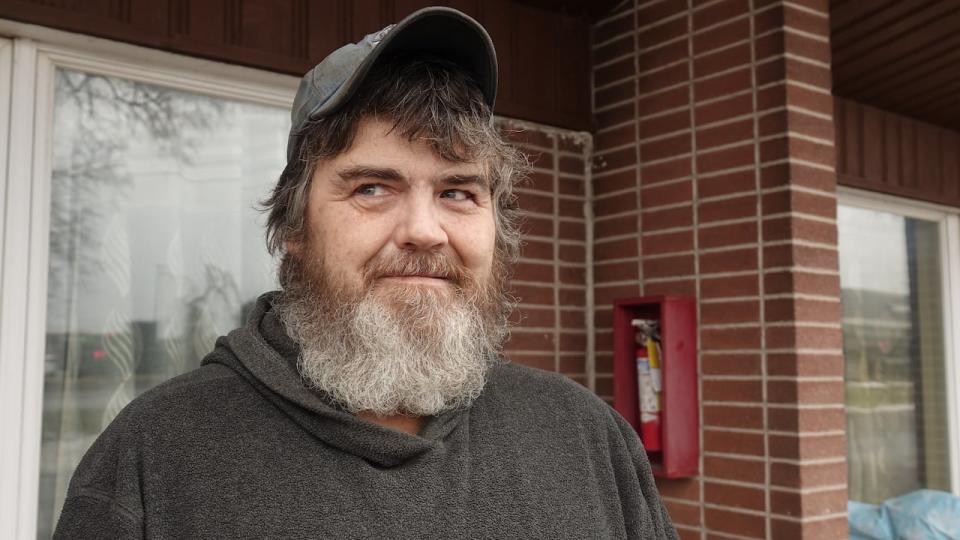Jun. 2—For the first time since 2021, Anchorage is entering the peak summer months with a city-run low-barrier homeless shelter open.
While Anchorage’s incoming mayor says keeping the shelter going is a priority, its future after the end of June remains uncertain because of an anticipated operator change and not-yet-resolved funding.
This summer, about 200 of the most vulnerable people in Anchorage are staying at the mass shelter on East 56th Avenue, just off of the Old Seward Highway. The shelter is situated inside what used to be the city’s Solid Waste Services administrative building. The cavernous space once housed garbage trucks, but is now home to unhoused people, who live in closely packed cots and are allowed two totes full of belongings.
The situation offers more shelter than the last two summers. In 2022, unhoused people were directed to camp at a municipal campground in East Anchorage when the Sullivan Arena shelter shut down for the summer. Last summer, the city offered no shelter at all. In its absence, large camps grew at Third Avenue and Ingra Street, near downtown, and at Cuddy Park in Midtown Anchorage. With more people living outside, outdoor deaths surged.
The numbers are not exact, but city officials have said they estimate more than 500 people are living outside around Anchorage this summer.
The cold-weather shelter was slated to close due to lack of funding as of June 1, but an Assembly appropriation for about $500,000 allowed it to continue operating through the end of this month, said Assembly member Felix Rivera, who chairs the city’s housing and homelessness committee.
After that, the city hopes it will receive about $4 million for Anchorage sheltering from the state, money that would allow the shelter to continue operating until October, according to Rivera. The funds made it into the state budget, but “it’s not guaranteed until the governor signs the budget,” said Rivera.
It’s not clear whether Gov. Mike Dunleavy will veto the funding or not. Dunleavy hasn’t yet made decisions about vetoes, his spokesman said.
“The budget bills have not been transmitted to the governor yet,” spokesman Jeff Turner said in an email. “Once that happens he will analyze the bills and decide what if any line item vetoes will be made.”
Operator questions
The city will also need to find another shelter operator: The private nonprofit that manages the mass shelter says it does not intend to run the shelter after the end of June.
“We’re going to focus on other things,” said Shawn Hays, Henning Inc.’s top executive.
Henning Inc. is under investigation by the Anchorage Assembly after a series of troubling text messages between employees and the city’s top homelessness official became public in May.
Rivera said a reporter was the first to tell him Henning wouldn’t be bidding to continue running the shelter. An investigation into the allegations against Henning — including text messages that raised questions about election interference — isn’t expected to wrap up for a few weeks.
“The allegations about Henning — very concerning to me,” he said. “I need to know if they have any validity or not. If they have validity I’d want to end any contractual relationship.”
Hays has denied the allegations. In a letter to the Assembly sent Tuesday, Hays wrote that the text messages were “misconstrued and out of context.”
Rivera said he hopes an existing organization will expand their capacity and take on running the shelter.
“Otherwise it’s difficult for me to imagine that a new operator out of whole cloth will come to existence,” he said.
The city health department plans to put out a request for proposals for an entity to operate the shelter from July through December, the department said. Last time, Henning was the only group that bid to operate a mass shelter, according to Hays.
All of the change is unfolding as Anchorage is poised to see a consequential leadership transition, with the administration of Mayor-elect Suzanne LaFrance set to take office on July 1.
In a statement, LaFrance said she was “committed to maintaining current shelter capacity and developing a comprehensive shelter plan ahead of winter.”
“My focus now is on building a competent, qualified team to prepare for the work ahead,” the statement said.
At the summer shelter
On Thursday morning, a van pulled up to the entrance of the shelter building and a slow trickle of people hopped out. They had moved out of the Aviator Hotel, a downtown non-congregate shelter operation that gave unhoused people their own hotel rooms. With funding for the program ending at the end of May, people had been trickling out and moving into other situations all month, according to Alexis Johnson, the city homeless coordinator.
The people stepping off the van at the shelter were among the last to move out. Some were close to being housed through transitional housing programs, said Hays. For them, the mass shelter would be a stopover.
“Hopefully they’ll be out within a couple weeks,” she said.
Inside, cots were packed together an arm’s length apart, a far cry from the days of social distancing at the cavernous Sullivan Arena. While the space is better in some ways than the Sullivan — a sports and entertainment arena with a lot of stairs, dark corners and concrete — it’s still essentially a garage, Hays said.
“We still think it’s inappropriate for people to have to shelter in a garage,” said Hays.
The demographic was older, with gray hair and wheelchairs dotting the room.
“We find that the people who want to be in shelter (in the summer) are people who need help” and want to work with case managers and get three meals a day, Hays said.
In the peak of summer months, “There are people that have been camping for decades that automatically just go right back outside,” she said.
Cindy Cornell sat outside the shelter. She’d been in every kind of shelter Anchorage had to offer over recent years — from Sullivan Arena to camping at Centennial Park in the summer of 2021 to Brother Francis and beyond. She’d more recently spent a lot of time at the shelter over the winter. Still, she’d gotten frostbite on her feet, with blisters that wouldn’t seem to go away, she said. She was on all the housing lists, she said.
Cornell said there weren’t enough bathrooms to accommodate the residents, or microwaves to heat the pre-packaged meals handed out.
Darrell Thompson sat in a wheelchair. He’s lived at Sullivan Arena, the Aviator Hotel, Complex Care and now here. Thompson said he had recently had surgery for an infection in his foot. He showed drains snaking out of his leg. He was also attached to a supplemental oxygen apparatus. It’s not easy to be disabled and live in a shelter, he said.
A friend handed him a bag with breakfast, packaged oatmeal.
“But there are some of the most generous, kindest people in the world here,” he said. “Also some not so much.”
The worst part about living in a shelter is the rules, he said. “They treat us like 5-year-olds here,” he said. “They tell us what we can do. Can’t do. When we can go in and when we can go out.”
Still, Thompson was of the mind that the shelter was necessary for summer.
“It’s keeping people off the streets,” he said. “If they were on the streets, Walmart, Carrs, Fred Meyer — they’re all getting ripped off. Because these people don’t have no food, no place to go.”
The number of people camping outside typically peaks this time of year, with the weather getting warmer, said Mike Braniff, the head of the Anchorage Parks and Recreation Department.
The city plans to dismantle a large encampment on the hill above the Alaska Railroad depot near Ship Creek on June 2. The camp was originally given 72 hours’ notice, but officials decided to allow its residents to have more time, Braniff said.
Meanwhile, other camps have sprouted up in new areas: Some of the people living in RVs and cars at Cuddy Park have moved to a short stretch of Fairbanks Street, on the north side of the Home Depot store. A dense camp of vehicles, tents and improvised structures has grown.
Fairbanks Street is “on the radar,” Braniff said, but there are no immediate plans.
A tent camp has also sprouted on the sidewalks of Karluk Street, near the Brother Francis Shelter in Ship Creek.
There are also no plans to dismantle that area right away, Braniff said.
Daily News reporter Emily Goodykoontz contributed.
Signup bonus from




